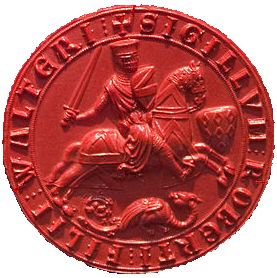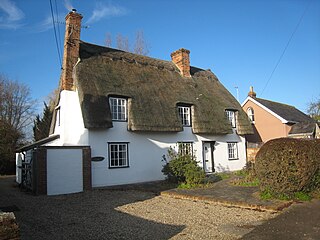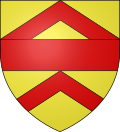
Magna Carta Libertatum, commonly called Magna Carta or sometimes Magna Charta, is a royal charter of rights agreed to by King John of England at Runnymede, near Windsor, on 15 June 1215. First drafted by the Archbishop of Canterbury, Cardinal Stephen Langton, to make peace between the unpopular king and a group of rebel barons, it promised the protection of church rights, protection for the barons from illegal imprisonment, access to swift and impartial justice, and limitations on feudal payments to the Crown, to be implemented through a council of 25 barons. Neither side stood by their commitments, and the charter was annulled by Pope Innocent III, leading to the First Barons' War.

Year 1215 (MCCXV) was a common year starting on Thursday of the Julian calendar.

Henry de Bohun, 1st Earl of Hereford of Pleshey Castle in Essex, was an Anglo-Norman nobleman who became Hereditary Constable of England from 1199.

Saer de Quincy, 1st Earl of Winchester was one of the leaders of the baronial rebellion against John, King of England, and a major figure in both the kingdoms of Scotland and England in the decades around the turn of the twelfth and thirteenth centuries.

St Andrew-by-the-Wardrobe is a Church of England church located on Queen Victoria Street, London in the City of London, near Blackfriars station.

The First Barons' War (1215–1217) was a civil war in the Kingdom of England in which a group of rebellious major landowners led by Robert Fitzwalter waged war against King John of England. The conflict resulted from King John's disastrous wars against King Philip II of France, which led to the collapse of the Angevin Empire, and John's subsequent refusal to accept and abide by Magna Carta, which John had sealed on 15 June 1215.

Baynard's Castle refers to buildings on two neighbouring sites in the City of London, between where Blackfriars station and St Paul's Cathedral now stand. The first was a Norman fortification constructed by Ralph Baynard, 1st feudal baron of Little Dunmow in Essex, and was demolished by King John in 1213. The second was a medieval palace built a short distance to the south-east and later extended, but mostly destroyed in the Great Fire of London in 1666. According to Sir Walter Besant, "There was no house in [London] more interesting than this".
Robert Fitz Richard (1064–1136) was an Anglo-Norman feudal baron of Little Dunmow, Essex and constable of Baynard's Castle in the City of London. His feudal barony, the caput of which was at Little Dunmow in Essex, was granted to him by the king after it had been forfeited in 1110 by William Baynard, whose grandfather Ralph Baynard was the first holder and the builder of Baynard's Castle in the City of London.

Robert Fitzwalter was one of the leaders of the baronial opposition against King John, and one of the twenty-five sureties of Magna Carta. He was feudal baron of Little Dunmow, Essex and constable of Baynard's Castle, in London, to which was annexed the hereditary office of castellan and chief knight banneret of the City of London. Part of the official aristocracy created by Henry I and Henry II, he served John in the wars in Normandy, in which he was taken prisoner by King Philip II of France and forced to pay a heavy ransom.
Montfichet's Tower was a Norman fortress on Ludgate Hill in London, between where St Paul's Cathedral and City Thameslink railway station now stand. First documented in the 1130s, it was probably built in the late 11th century. The defences were strengthened during the revolt of 1173–1174 against Henry II.
Sir James Clarke Holt, also known as J. C. Holt and Jim Holt, was an English medieval historian, known particularly for his work on Magna Carta. He was the third Master of Fitzwilliam College, Cambridge, serving between 1981 and 1988.

The Barony of Halton, in Cheshire, England, comprised a succession of 15 barons and hereditary Constables of Chester under the overlordship of the Earl of Chester. It was not an English feudal barony granted by the king but a separate class of barony within the County Palatine of Chester.

Little Dunmow is a village situated in the Uttlesford district, in rural Essex, England, in the vale of the River Chelmer about 3 miles (4.8 km) east-southeast of the town of Great Dunmow. It can be reached from the Dunmow South exit of the A120 by following the road towards Braintree (B1256) for 3.2 km before turning right for the village. The centre of the old village, which has just 99 dwellings, is a further 0.6 km along the road. The Flitch Way, a linear country park along the route of the old Braintree to Bishop's Stortford railway, links Little Dunmow and the new settlement of Flitch Green. The new village, built on the site of a former sugar beet factory, is a self-contained community of 850 dwellings and is another kilometre along the road towards Felsted.

Robert FitzWalter, 1st Baron FitzWalter was an English landowner, soldier, administrator and politician.
Walter Fitz Robert of Woodham Walter, lord of Little Dunmow, Essex, was steward under Stephen of England, having succeeded to that position upon the death of his father, Robert Fitz Richard. Walter died in 1198 and was buried at Little Dunmow, in the choir of the priory of Austin canons.
Events from the 1210s in England.

Little Dunmow Priory in Little Dunmow was an Augustinian priory in Essex, England. The priory was founded as a church by Juga de Baynard in 1104, dedicated to the Blessed Virgin Mary and consecrated by Maurice, bishop of London. Juga was the widow of Ralph Baynard, baron of Little Dunmow, sheriff of Essex and builder of Baynard's Castle in the City of London, since demolished. Her son Geoffrey was sheriff of Yorkshire who, in 1097, beat William II, Count of Eu in a trial by battle. After her death (c.1106), and following her wishes and the advice of Anselm, the Archbishop of Canterbury, Geoffrey populated Juga's church with Augustinian canons. In 1110, Lady Juga’s grandson, and Geoffrey’s son, William de Baynard, fell from grace and lost his lands. Henry I gave those lands to Robert Fitz Richard, but Henry and his wife Matilda of Scotland confirmed the canons’ possessions in Little Dunmow. Robert’s wife Maud, the step-daughter of Matilda’s brother David I, gave more lands to the canons, establishing the priory in perpetuity.

John de Lacy, 2nd Earl of Lincoln was hereditary Constable of Chester, 7th Baron of Pontefract, 8th Baron of Halton and 8th Lord of Bowland.

The Constable of Chester was a mediaeval hereditary office held by the Barons of Halton. The functions of the Constable are unclear, possibly they related to the custody of Chester Castle, as was the main function of most mediaeval constables, but Sanders (1960) says the office-holder was constable for the entire County Palatine.

John FitzWalter, 2nd Baron FitzWalter was a prominent Essex landowner best known for his criminal activities, particularly around Colchester. His family was of a noble and ancient lineage, with connections to the powerful de Clare family, who had arrived in England at the time of the Norman Conquest. The FitzWalters held estates across Essex, as well as properties in London and Norfolk. John FitzWalter played a prominent role during the early years of King Edward III's wars in France, and at some point, FitzWalter was married to Eleanor Percy, the daughter of Henry, Lord Percy.















